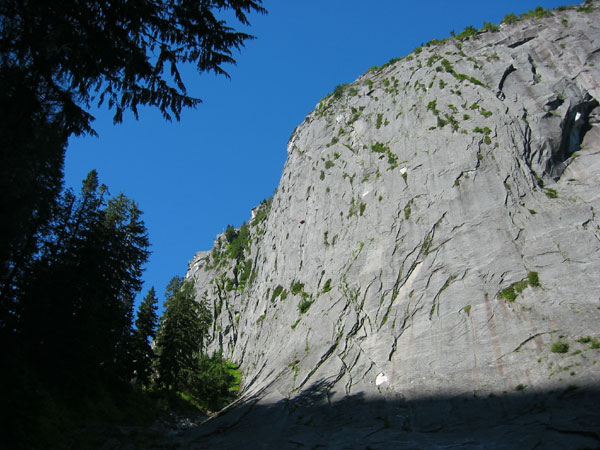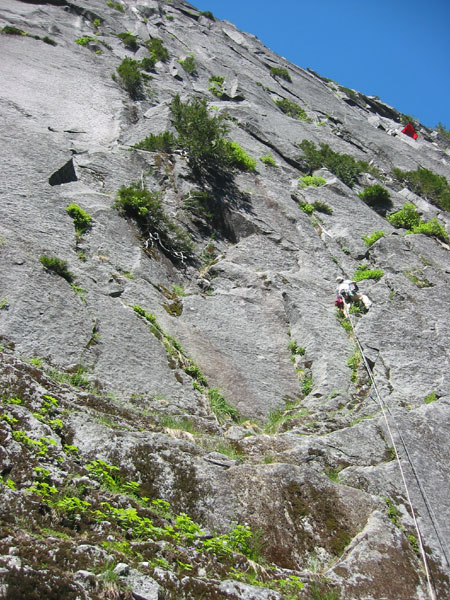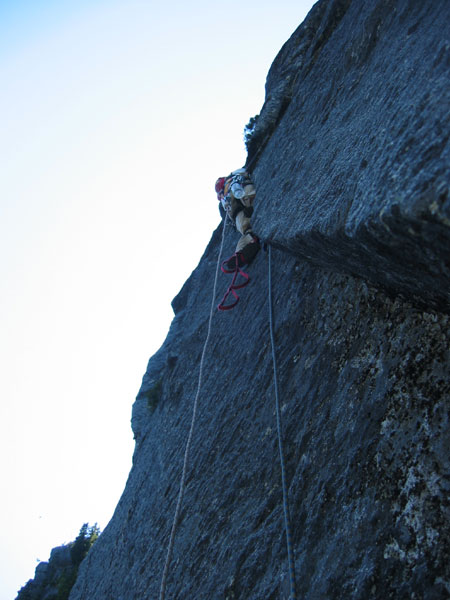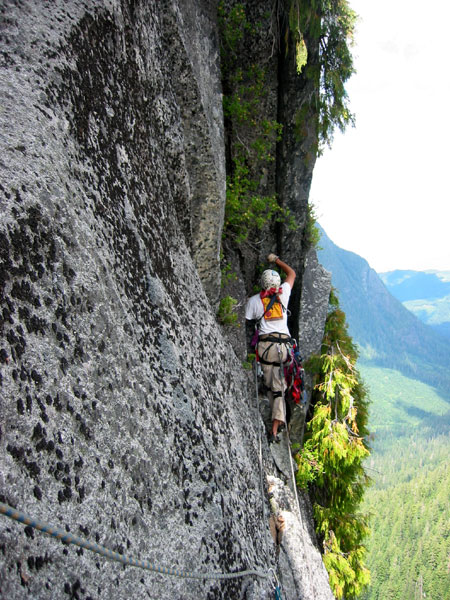Exfoliation Dome - VooDoo Wall
Many days in July and October 4-5th, 2003
Dave Whitelaw, Chris Greyell and Mark Hannah were developing a new aid
line on the far east end of the Witch Doctor Wall, an area they were dubing
The Solar Wall. Intrigued by the awe inspiring pictures, I raked Mike
Swanike up from his Oregon based internship and we decided to try and
establish another new line. Little did we know how much WORK (versus climbing)
we were in for.
Round 1 _____________________________________________________________________________
Mike and I hump a load up to the base of the wall in a blistering July
heat. We're carrying a double rack, three 60m ropes, a hammer, pins, aid
gear, and a measly little bolt kit that was more a kin with the 1960s.
The trail was existent and easy to follow thanks to the Whitelaw et al
party's efforts, something that we appreciated very much with the heavy
load and the unknown terrain. After a quick 45 minutes, the main Witch
Doctor Wall comes into view... an awesome sight.

The impressive Witch Doctor Wall on Exfoliation Dome.
The Solar Wall area is around the buttress on the left skyline.
After an hour and a half of walking we arrived at the two bivi rocks
below the base of the wall. Above we could see the other guys up on the
wall, working their route Solaris (IV 5.10b A2+).

A profile of the Solar Wall area with haulbag and portaledge just visible
on top of Solaris's stellar hand-fist crack.
The original line that we had scoped on the pictures revealed its self
as a cup full of epic: what we though might be splitter hand cracks were
infact huge bombay chimneys, detached flakes, etc. It didn't take
us long, however, to spy another thin crack system that snaked up through
a long left facing corner system. The lower few pitches seemed straitforward,
but the upper blank looking section seemed ominous. We decided to deal
with it when we got there, and started racking up.
The first pitch goes free up ledges with some 5.6 moves until a short
and (now) clean left facing corner crack leads up to a ledge just below
Bombardier Ledge. On the original climb, Mike bypassed the dirt clogged
crack by climbing up a tree growing down the wall! (Emily and I later
returned and removed a ton of dirt and foliage from the first pitch. Many
thanks to her for helping make it a much nicer pitch!)

Having defeated me at rock paper scissors, Mike takes the first steps
into the unknown.
Mike climbed up on top of Bombardier Ledge and set a belay with all of
our largest gear. I jugged up, reveling at how I'd never jugged through
a bush until I came to Darrington. The crack that leaves the ledge presented
a small problem. It was the same size as our belay's gear. Hmmm.. resourceful
climbers we are, we back the belay up with a pin off to the side of the
crack and I take two of the large pieces (#4 camalot and #6 tricam). The
crack is moderate free climbing (5.8), but I aid up it, cleaning the lichen
off as I go. Fortunately, the small stuff falls directly into my eyes,
while the dinner-plate sized chunks go wizzing off and hit Mike at the
belay. I begin to think that this is pretty dirty... Little did I know.
I reached some flakes and figured that we couldn't go higher without
drilling at least one bolt. Seeing as it was late in the day by now, I
slung the flakes and rapped back down, leaving the rope fixed. We then
rapped all the way down and met up with the guys back at their camp on
the rocks. Having just pushed their route to the top of "The Ear"
and having only 1 pitch left to do to reach "Solar Ledge" (the
end of the aid climbing), they were pretty stoked. That night they introduced
us to all the fine arts of Darrington route establishment. Powerdrills
(oooh), joint knives, brush saws, tool-belts, etc... Their mastery of
this strange form of climbing impressed us and we were to become their
deciples. "Beware the evil powers of the wall cedar."

Now we're talking! Dave finishing the second half of the 2nd pitch.
Photo: David Whitelaw.
The next day the guys generously offered us their drill, as well as some
more modern anchors, so we headed up with renewed excitement. We jugged
up to our highpoint and I continued up the second half of the pitch. Pleasantly,
the moves off the flakes went clean, and I continued up a beautiful left-facing
flake. As I approached the little ledge at the top of the pitch, an evil
looking moss patch filled the crack. I pulled out the saw and started
hacking away. Before I knew it, the tuffet went plummeting down between
my legs, and I could barely yell "Rock!" before I saw it explode
into a plume of dust off of Mike's helmet. Ouch. As I continue to saw
at the dirt it pours all over me, filling every crevice and orifice. On
the ground, the guys watch and laugh as we go. Exhausted by the heat,
the weight of a big rack and a 14 lb. drill, I pull onto the ledge and
drill an anchor. The corner system above looks excellent, but this will
be it for the day as mike needs to drive back to Portland tonight. We
leave the ropes fixed, all fired up to return in a couple weeks.
Round 2 _____________________________________________________________________________

Uh-oh. Is that a haulbag?
We come back with the full regalia of wall climbing equipment: Portaledge,
expedition fly, haulbag... in other words, an even more punishing load
than the first time. The hike is slower, and the wall is empty when we
arrive at the base. We load up our water bottles at the stream behind
camp, and load up the pig for our push up the wall.

Mike following the pig up the wall.
Mike joins me at the top of the second pitch and launches off up the
clean corner above. Finding easy aid, he runs it waaaay out off the belay.

Mike leading the third pitch.

Me following the nice upper corner of the 3rd pitch.
Mike reaches another perfect and large ledge at 30 meters and drills
in the anchor. We've reached our goal for the day, and by the time we've
hauled and setup the portaledge the sun is already starting to dip behind
the hills in the West. Soon we are living large with canned chili, tons
of water, and a beautiful view.

Mike enjoys dinner as the sun sets.
The next morning we wake up to blazing sun, and I rack up for my lead.
From the pictures this pitch looks long and blank. I'm nervous as I walk
away from Mike's posh portaledge belay and start the day off with a black
Alien. I follow the crack around a corner where another thin crack leads
upwards. This trend continues as I link up discontinuous crack systems
until I reach the very blank looking section about 30 ft. below the corner
system that I hope will take me to what I think is a ledge at the base
of "The Shield" feature. I spy a paper thin crack running down
from a tree above, and am just able to aid over to it. Sure enough, it's
a perfectly beautiful A1 knifeblade crack. I put in several pieces before
drilling a rivet to go right to the corner system. The corner turns out
to be trickier than it looks, and despite most attempts to get a black
Alien in, I end up nailing most of the corner (A2).

Relishing the exposure and thin cracks on pitch 4.
After a scant 4 and a half hours, I reach the existent ledge and drill
the anchor. I'm nearly physically spent and am just barely able to hold
the drill above my head. Mike juggs up, and graciously cleans all of my
pins. The one thing I've forgotten to tell him, I realize as he approaches
me, is to bring the extra drill battery up. It was feeling a bit weak,
and we'd already drilled close to it's expectancy on this battery. Regardless,
Mike heads off on pitch 5, and begins to climb up onto The Shield.

Mike leads an airy overhung crack up the Shield.
Things are going well and Mike is finding relatively easy aid up a flake
until about 30 feet below Solar Ledge. Here the crack runs out, and all
the surrounding flakes do too. I send the drill up the zip line. Knowing
that he's only got a few holes, Mike starts bat hooking (drilling holes
to place a narrow pointy hook into) because it uses less power. After
alternating hooks and rivets, as he's drilling the 4th hole, the battery
dies... gone. So, I leave him swaying in the wind, hanging off a bat hook,
while I rap down our fixed line back to the bivi. As I begin the return
trip back up the line, the ominous clouds that had been building begin
to sprinkle. A few moments later we are in a full on downpour with hail
and waterfalls crashing down the wall. Once I reach the belay, I zip the
battery and a goretex jacket up to Mike who has been enjoying a private
wet t-shirt contest. A while later, Mike reaches the ledge where our route
and the Solaris route will merge. After climbing quite a ways above the
ledge on the low angled ground above, he decides to come back and set
the anchor at the top of the steepness. An hour later we begin the rapps
back down to the ledge, making it there just as darkness falls.

Reeling mike back to the bivi, in the rain, in the dark.
We couldn't get into that portaledge any sooner!
Arriving back at the ledge, we were overjoyed to have fussed with setting
the ledge up through the rainfly the night before. It was a bit inconvenient
then, but boy was it nice to pull that tent over the ledge and hop in.
The next morning we packed up our stuff, filled the haulbag and began
to descend. One full 60 meter rapp brought us back to Bombardier ledge
(bypassing the pitch 2 anchors), and from there it was another almost
full 60 to the ground. For ease in rappelling the route, as well as the
185 foot 4th pitch, 60 meter ropes are recommended for this route. However,
an intermediate belay could be established on a smaller ledge about half
way up the fourth pitch. Another advantage to 60m ropes is that you can
fix from the top of pitch 3 down to the top of pitch 1. From here a 50
meter rope would reach the ground.
Round 3: The Complete Ascent __________________________________________________________
Sufficient time had passed since July, and the memories of heavy loads
and fierce rainstorms had faded. Mike and I had just returned from Yosemite
and still had wall climbing on our minds. It was time to go back and finish
what we'd started.
We headed out Saturday morning from Seattle, hitting the trail around
9:30. The hike in was quick with a more normal climbing rack (only
a double rack to #4 camalot and just two 60m ropes). Our plan was
to fix the first two or three pitches today, then complete the rest Sunday.
This time we lead the pitches that the other had previously.

Mike following the stout fist crack up onto Bombardier Ledge.

Mike free climbing at the start of the second pitch.
Mike climbed the wide crack off of Bombardier Ledge cleanly,
and soon we were both on top of pitch 2. With plenty of daylight left
and the knowledge that two 60 m ropes would reach the ground from the
top of the 3rd pitch, I lead off. The third pitch is a quality one with
some of the most continuous splitter cracks on the route. It might go
free at hard 5.10, but who knows... We fixed our lines down and were back
in camp for chili before the sun had set.
We woke up at day break and got to jugging back up. I was
exhausted by the time I reached the ledge on top of 3, but luckily it
was Mike's lead on the crux 4th pitch. I had plenty of time to relax and
contemplate the beautiful fall colors of our surroundings.

Dave taking in the morning sun as Mike leads the crux pitch. Photo by
Mike.

Dave following the 4th pitch. Photo by Mike.
I lead the 5th pitch up The Shield, finding it to have awesome
position. A thin splitter crack slashes across a steep face of granite
with the wall scooping away below. Too soon the crack runs out and I have
to bolt and bat hook my way up towards Solar Ledge. The trick for finding
the bat hooks is to look for the next bolt or rivet and imagine a line
between you and them. They are small 1/4" holes and aren't too hard
to find. Also, you never have to do more than one at a time, so one hook
will do.
By the time we were both on Solar Ledge it was getting late
in the day. As Mike put on his rock shoes I quickly climbed the first
half of the last pitch. It has some fun climbing up a wide flake that
leads to a very Nutcracker-ish mantle past a bolt. Due to the big traverse
in the middle of the 6th pitch, we decided to break it into two shorter
ones. Mike soon joined me and lead up the final corner to the top. We
tagged the ridge crest and headed for home... We had only an hour and
a half of light left.

Dave and Mike on top!
We rapped down Solaris because it's rapps are strait
down from the anchors on Solar Ledge. From the top it is 6 steep rappels
all the way down, but it went quick and we touched down just as dusk started
to settle in. It had been an ass kicking weekend, but we were glad to
have completed it. We called our route Voodoo Wall (IV 5.10 A2).

An overview of the route.

|

